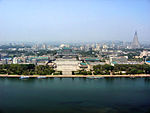Pyongyang
This is your travel guide for Pyongyang, Korea (the Democratic People’s Republic of)
1 : Kim Il-sung Square [1.5 hrs]
Kim Il-sung Square is the heart of Pyongyang and a significant site for political events and parades. The square is named after the founding leader of North Korea and features a large statue of him, which is a popular spot for both locals and tourists. Visitors can observe the grand architecture surrounding the square, including the Grand People’s Study House and the Kim Il-sung Palace of Culture. It’s a great place to experience the atmosphere of the city and its historical significance.
2 : Mansudae Grand Monument [1 hr]
The Mansudae Grand Monument consists of towering bronze statues of Kim Il-sung and Kim Jong-il, located on Mansu Hill. This site is a place of reverence, where visitors can pay their respects by laying flowers at the base of the statues. The monument is an iconic symbol of North Korean ideology and is often visited by both locals and tourists. The surrounding park area provides a serene environment for reflection and photography.
3 : Arch of Triumph [1 hr]
The Arch of Triumph in Pyongyang is a monumental arch built to commemorate the Korean resistance against Japanese colonial rule. Standing taller than its counterpart in Paris, this arch features intricate carvings and inscriptions that celebrate the history of the Korean people. Visitors can climb to the top for a panoramic view of the city and the surrounding area. It’s a significant landmark that showcases the pride of the North Korean people.
4 : Korean War Museum [1.5 hrs]
The Korean War Museum offers an in-depth look at the history and events of the Korean War from the North Korean perspective. The museum features a variety of exhibits, including military equipment, photographs, and detailed narratives of the war’s impact on the Korean Peninsula. Guided tours are available, providing insights into the country’s historical narrative and its ongoing significance. This visit is essential for understanding the context of North Korea’s current political landscape.
5 : Pyongyang Metro [1 hr]
The Pyongyang Metro is one of the deepest metro systems in the world and is known for its ornate stations and efficient service. A ride on the metro provides a unique glimpse into daily life in Pyongyang, as well as the opportunity to see the beautifully decorated stations. The metro is not only a means of transportation but also a showcase of North Korean art and culture. Visitors can experience the contrast between the modern infrastructure and the historical context of the city.
Background Info
Weather
In October, Pyongyang typically experiences mild weather with average temperatures ranging from 10°C to 18°C (50°F to 64°F). Rainfall is minimal, averaging around 30 mm, and humidity levels are moderate, around 60%. Air quality is generally acceptable, but can vary depending on industrial activity.
Language
The official language is Korean, specifically the Pyongan dialect in Pyongyang.
Cost Of Living
The cost of living index in Pyongyang is relatively low compared to many Western countries, but it can be high for foreigners due to limited availability of goods and services.
Other
Tourism in North Korea is heavily regulated, and visitors must be part of an organized tour. Photography is restricted in certain areas, and travelers are advised to follow local guidelines closely.
Chung-guyok – district of Pyongyang
Location: Pyongyang, P’yǒngyang , Korea (the Democratic People’s Republic of)![]()
Summary: Chung-guyok Summary
Map: Map of Chung-guyok
Weather: Chung-guyok Forecast
Official Names: 중구역 (North Korean standard language), 중구역 (Korean), 中區域 (Korean)
Population: 131,333 (2008)
Coordinates: 39.02, 125.75
Timezone: (UTC+09:00) Korean Standard Time (Pyongyang)


